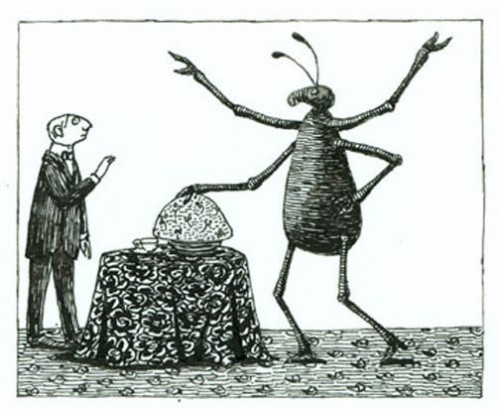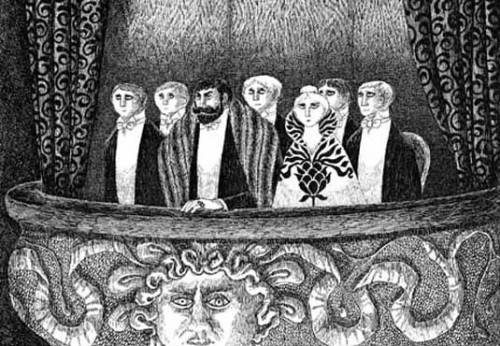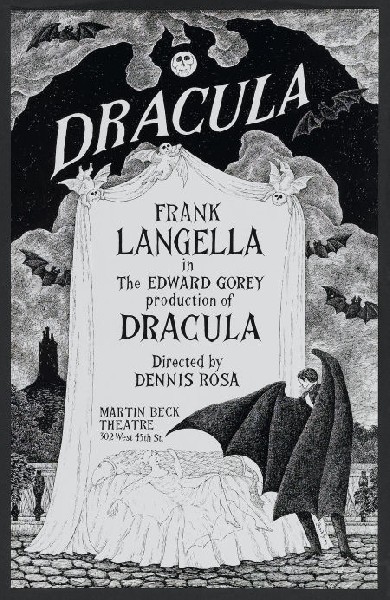Edward Gorey At Boston Athenaeum
Draftsman of the Amusing Dark Side
By: Mark Favermann - Mar 05, 2011
Like laughing during a nightmare, the visual bouillabaisse always seems to include a pinch of carnivorous plant, a section of falling masonry, a feather from an unrecognizable evil bird, a piece of a heart of an unknown strange large creature and a fingernail or two of uninvited guests all peppered with the shadows and shading of a droll wit and an elegant line. This visual banquet is the imaginary world of artist and author Edward Gorey. His illustrated stories teeter on the crevice between the hilarious and the horrific, the delightful and the dreadful.
This small but elegantly dense exhibition (only ten visitors at a time) explores the diversity of Gorey’s art through original pen and ink illustrations, preparatory sketches, unpublished drawings, and various pieces of ephemera. Drawn from the holdings of the Gorey Charitable Trust, the exhibit includes about 180 objects, including selections from The Gashlycrumb Tinies, The Unstrung Harp, The Gilded Bat, and other well-known Gorey publications.
Edward Gorey defined American eccentric. Though his work seemed to be placed somewhere in the dark recesses of Victorian or Edwardian England with a certain Jazz Age panache, he only visited England once in his life for just three days. He never saw London. Perhaps, it was the bad weather or worse food? In fact, he traveled very little in the United States as well, staying mostly in New York City or on Cape Cod. He always wore sneakers and in Winter a long fur coat. His full beard was a trademark.
He tended to be a man of habit and routine, always eating at the same diner for breakfast (Jack's Outback) on the Cape (he lived for many years in Yarmouthport) and for decades never missing a performance of the New York City Ballet. Apparently he loved Jack's flapjacks or coffee and Balanchine's genius. His Midwestern childhood, eclectic literary interests and his Harvard education (Gorey's college roommate was poet Frank O'Hare) somehow gave free reign to his darkly drawn imaginative creations. This and Gorey’s eclectic and voracious reading, admiration of cats and off-beat and wry view of the world resulted in a sardonic and yet strangely droll oeuvre.
Edward St. John Gorey was born in 1925 in Chicago and died in 2000 on his beloved Cape Cod. Gorey wrote, illustrated, and published over 100 books. He also illustrated the writings of other authors including Charles Dickens, Edward Lear, Virginia Woolf, John Updike, and Muriel Spark. Examples of his work appeared in the New Yorker and the New York Times Perhaps best known are his signature privileged Victorian gentlemen and languishing ladies that animate the opening credits of PBS’s Mystery series.
The theatricality of Gorey’s creations meant an easy translation into wonderfully graphic stage productions in New York, on Cape Cod, on Nantucket, at the American Repertory Theatre (A.R.T.) and elsewhere. He won the 1978 Tony Award for his costume designs for Dracula.
Elegant Enigmas: The Art of Edward Gorey, on view at the Athenæum through the spring (February 9 through June 4, 2011), includes over 150 drawings that Gorey made for over thirty of his books (published between 1953 and 2006), as well as an engaging assortment of archival material including sketchbooks, illustrated envelopes, book-cover ideas, and theatrical costume designs. Each of this artist’s works are imbued with macabre sensibility, subtle wit, and charming historicism of Gorey’s very individualistic style. Often technically brilliant in their economy of line and precise detail, these drawings have a magical quality that like the artist himself are difficult to actually define.
Certainly, there have been other wonderful artists who have been influenced by Edward Gorey’s work like filmmaker/artists Tim Burton and David Lynch as well as children’s writer Lemony Snicket’s Daniel Handler. However, this exhibition underscores the fact that Gorey was a one-off.
Edward Gorey himself would never explain his work. The work he felt was beyond explanation. Perhaps, that is what makes them so appealingly human and oddly and darkly humane.
.









